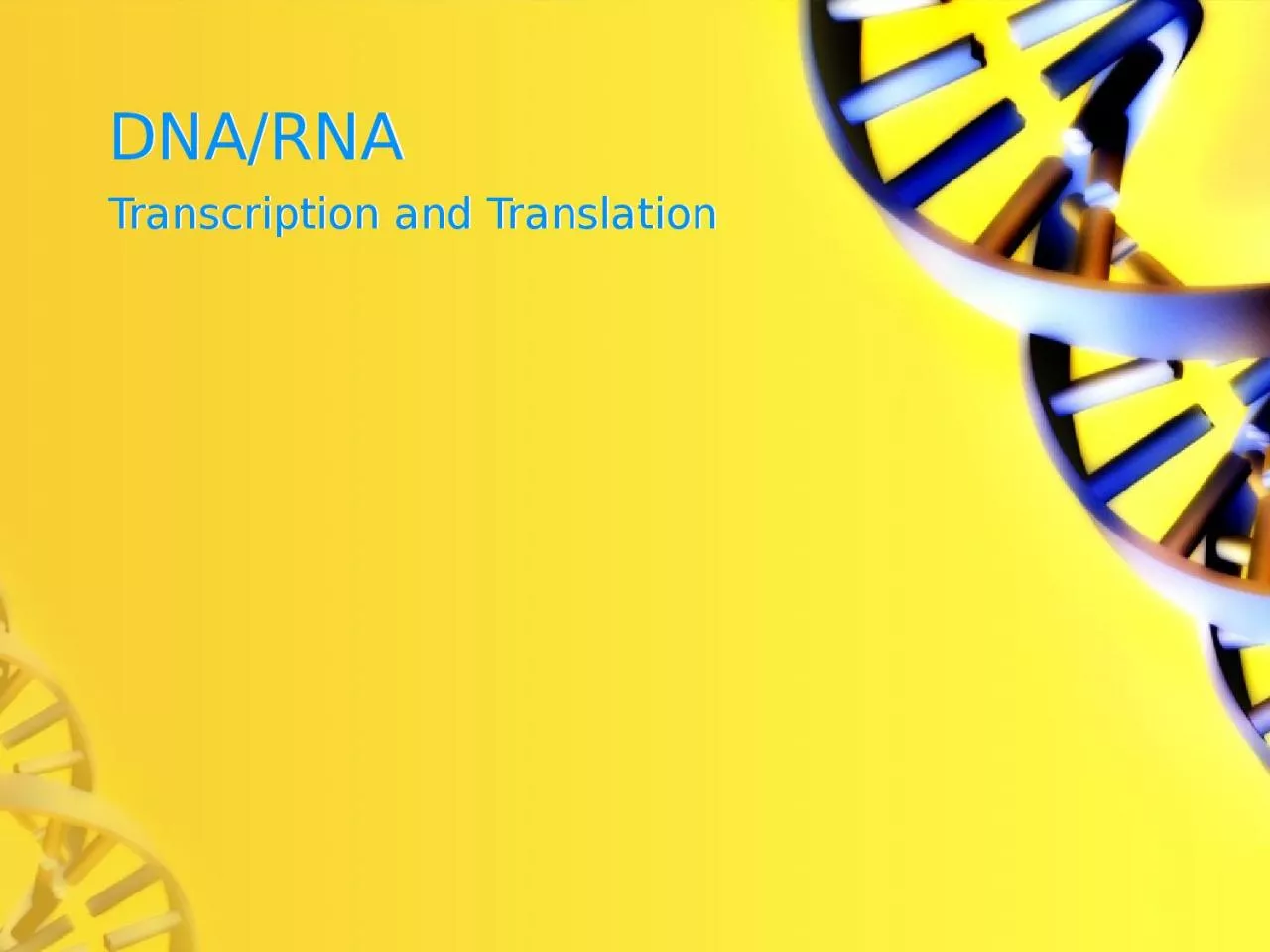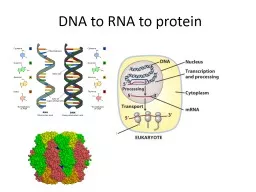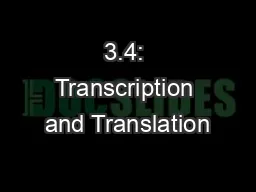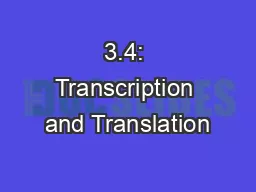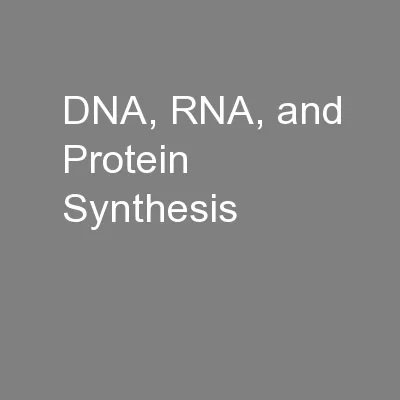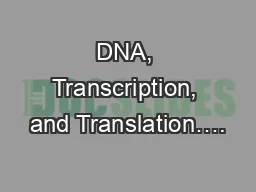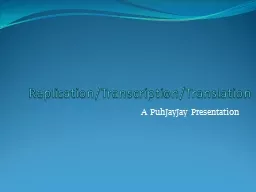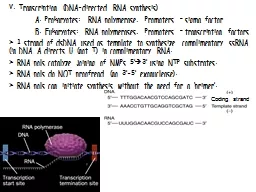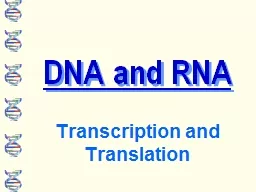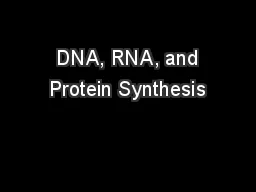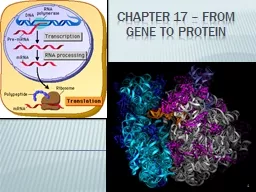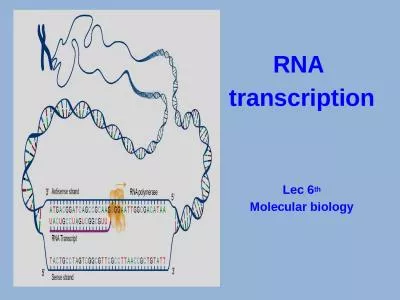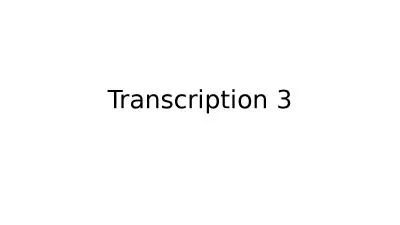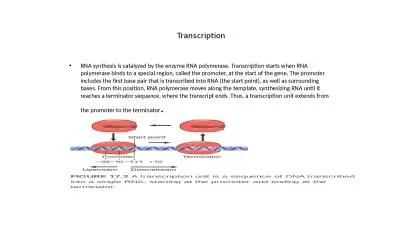PPT-DNA/RNA Transcription and Translation
Author : ceila | Published Date : 2024-01-29
Review DNA is responsible for controlling the production of proteins in the cell which is essential to life DNA RNAProteins Chromosomes contain several thousand
Presentation Embed Code
Download Presentation
Download Presentation The PPT/PDF document "DNA/RNA Transcription and Translation" is the property of its rightful owner. Permission is granted to download and print the materials on this website for personal, non-commercial use only, and to display it on your personal computer provided you do not modify the materials and that you retain all copyright notices contained in the materials. By downloading content from our website, you accept the terms of this agreement.
DNA/RNA Transcription and Translation: Transcript
Review DNA is responsible for controlling the production of proteins in the cell which is essential to life DNA RNAProteins Chromosomes contain several thousand genes each with the directions to make . and Its Regulation. January . 21 . –Mechanism of Transcription Initiation. January . 23– Regulation of of Transcription Initiation. January . 27–Mechanism and regulation of Transcription Elongation. Gene . to . Phenotype. : . The BAD2 gene. . and . fragrance in rice. DNA . sequence specifying . a . protein 200 . – 2,000,000 . nt. (. bp. ). Eukaryotic Gene Structure. Ribonucleic acid (RNA) is a key nucleic acid in transcription and translation. RNA is like DNA except that:. 3.5.1: Compare the structure of RNA and DNA.. 3.5.1: Compare the structure of RNA and DNA.. IB Question: . Compare the structure and composition of DNA with RNA. . [4]. both are polymers of nucleotides / both nucleic acids;. DNA directs the activities of the cell by controlling the proteins the cell produces.. This determines what the cell becomes, what it synthesizes, and how it functions. Gene Protein occurs in 2 steps Transcription and Translation. Chapters 16 and 17. Before the end of the semester we will be covering…. Historical DNA experiments. Structure of DNA/RNA. DNA Replication. Protein Synthesis (Transcription and Translation). Mutations. Why Should We Learn About DNA?. To understand how genes are inherited and expressed.. To understand the evolution of the Earth’s diversity and protect it.. To understand the relationships between species.. A . PuhJayJay. Presentation . Daily Catalyst . 1. If there are 34% of Adenines in DNA, what is the percentage of . uracil. in RNA?. 34%. 2. . . Replicate. the following segment of DNA:. 5’- ATCGGCTACGTTCAC -3’. synthesis). A. Prokaryotes: RNA polymerase, . Promoters – sigma factor. B. Eukaryotes: RNA polymerases, . Promoters – transcription factors. . 1 strand of . dsDNA. used as template to synthesize complimentary . What do all of these organisms have in common?. . They all share a universal genetic code.. DNA and RNA are Nucleic Acids. What is a nucleic acid?. Nucleic acids are one of the major organic biomolecules.. Chapters 16 and 17. Before the end of the semester we will be covering…. Historical DNA experiments. Structure of DNA/RNA. DNA Replication. Protein Synthesis (Transcription and Translation). Mutations. 1. The information content of genes is in the form of specific sequences of nucleotides along the DNA . strands. The . DNA of an organism leads to specific traits by dictating the synthesis of proteins and of RNA molecules involved in protein synthesis (. th. Molecular . biology. According to . central dogma . , the genetic information flow from DNA the RNA via transcription process then it will translate later to functional protein. . Transcription . A eukaryotic transcription initiation complex consists of RNA polymerase II, . five. general transcription factors (GTFs), and a 20-subunit complex called Mediator (or . Srb. /Med). The CTD of RNA polymerase II anchors Mediator to the polymerase. Mediator allows RNA polymerase II to communicate with transcriptional . .. The length of the transcription bubble is about 12 to 14 . bp. , but the length of the RNA–DNA hybrid within the bubble is only 8 to 9 . bp. . As the enzyme moves along the template, the DNA duplex reforms.
Download Document
Here is the link to download the presentation.
"DNA/RNA Transcription and Translation"The content belongs to its owner. You may download and print it for personal use, without modification, and keep all copyright notices. By downloading, you agree to these terms.
Related Documents

